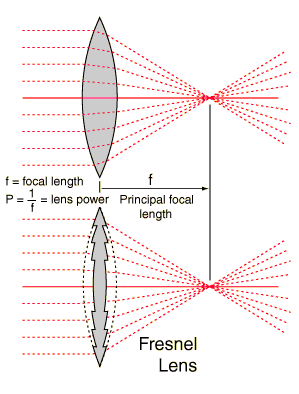Fresnel Lens
 |
Faced with the need to construct a large lens for a lighthouse of appropriate focal length, but unable to support the large weight of a double convex lens of that size, French physicist Augustin Fresnel (1788-1827) reasoned that it was the surface curvature which gave the focusing power. He reproduced the surface curvature of the thick lens in sections, maintaining the same focal length with a fraction of the weight. The lens strength in diopters is defined as the inverse of the focal length in meters. Besides the glass Fresnel lenses you see in old lighthouses, large Fresnel lenses made from molded plastic are used for certain focusing tasks. The optical quality is not sufficient for good imaging because of the scattering you get at the junctions between the curved segments, resulting in rings of light in the image plane. |
The principal focal length of a lens is determined by the index of refraction of the glass, the radii of curvature of the surfaces, and the medium in which the lens resides. It can be calculated from the lens-maker's formula for thin lenses.
Lens concepts
| HyperPhysics***** Light and Vision | R Nave |